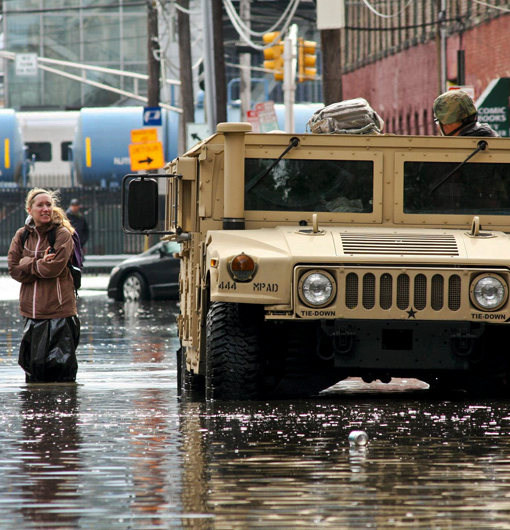
As Climate Change Worsens Storms, the US Military Must Prepare
In recent years, the U.S. has experienced several devastating storms. These storms have cost human lives, billions in damage, and created a threat to U.S. national security. As the climate continues to change, scientists predict these changes will make storms, like Hurricane Dorian, worse. Worsening storms will increase the cost to taxpayers and the threat to national security; the U.S. military must prepare now.
Why are scientists predicting worsening storms?
The threat from hurricanes comes in two forms—extreme rainfall and high winds—and scientists are predicting that these threats will worsen as a result of climate change. What is happening to worsen storms?
- Hurricanes derive energy from warm ocean water; sea temperatures are rising approximately 0.13°F per decade.
- Warmer air can hold more moisture. Across the globe, temperatures are warmer than average. In 2018, the surface temperature was 2.02°F above the 20th century average. More moisture can lead to more rain, causing high levels of inland flooding, which was true of Hurricanes Florence and Harvey.
- Sea levels rise at a rate of about one-eighth of an inch per year, creating even more inland flooding.
- Climate change is weakening the atmospheric currents that move weather systems along. Weakening currents mean 150+ mph winds, storm surges, and stunning amounts of rain stall in one place, as happened in the Bahamas with Hurricane Dorian.
What is the U.S. military’s response?
As climate change worsens storms, the threat to U.S. national security grows. As residents of the southeast U.S. prepare for Hurricane Dorian, so is the U.S. military. According to U.S. Northern Command chief Air Force Gen. Terrence O’Shaughenessy, more than 4,000 National Guard troops are pre-staged in Florida; Georgia and South Carolina have activated another thousand or so troops. Fort Stewart, near Savannah Georgia, evacuated in anticipation, as did Marine Corps bases Parris Island and Beaufort Air Station in South Carolina. According to Military Times, more than 40 helicopter crews from Fort Hood, Texas are pre-positioned for disaster response, as are more than 80 high-water vehicles from Fort Bragg, North Carolina. Furthermore, search-and-rescue air assets from Moody Air Force Base in Georgia and Virginia’s Naval Station Norfolk are also prepositioned to respond if needed.
When troops are diverted to prepare for and respond to storms, they are not training for traditional security threats. In September of 2018, military personnel at Camp Lejeune were diverted from their scheduled deployment to respond to Hurricane Florence. While diverting troops from normal activities to prepare for worsening storms is a threat to national security, so is the financial cost associated with the damage.
During a trip to Camp Lejeune in May 2019, ASP CEO Brigadier General Stephen Cheney, USMC (Ret) saw first-hand the damage caused by Hurricane Florence. It is estimated that $3.6 billion in damage was caused at Camp Lejeune, Marine Corps Air Station New River, and Marine Corps Air Station Cherry Point. U.S. Marine Corps Gen. Robert Neller said that he was forced to curtail or cancel several training exercises to free up funds for hurricane repair.
Hurricane Florence is not the only storm to have caused significant damage to U.S. military assets. In October 2018, Tyndall Air Force Base was hit hard by Hurricane Michael. Experts expect it will take years to rebuild and cost over $3 billion. In part due to the damage at Tyndall and Offutt Air Force Bases, the Air Force may be forced to ground combat aircraft, defer at least 61 facility repairs, and non-deploying squadrons may have their flying hours cut. Such cuts will affect military readiness and put U.S. national security at risk.
What do we need to do to prepare?
As scientists have predicted, storms will likely worsen as a result of climate change. As such, U.S. military personnel and assets will continue to be used to prepare for and respond to storms, preventing normal activities. Furthermore, the financial cost from damage done to military installations and assets will continue to mount.
The U.S. military must prepare for such a future.
- The services must recognize, train, and prepare for disaster response. That said, they must realistically assess how many disasters they can simultaneously respond to.
- Future base planning must consider the likelihood of worsening storms. Building bases to weather future storms will lower the risk of bases going offline and the financial costs associated with rebuilding.
To learn more about U.S. military resilience, check out ASP’s new Military Resilience website.





